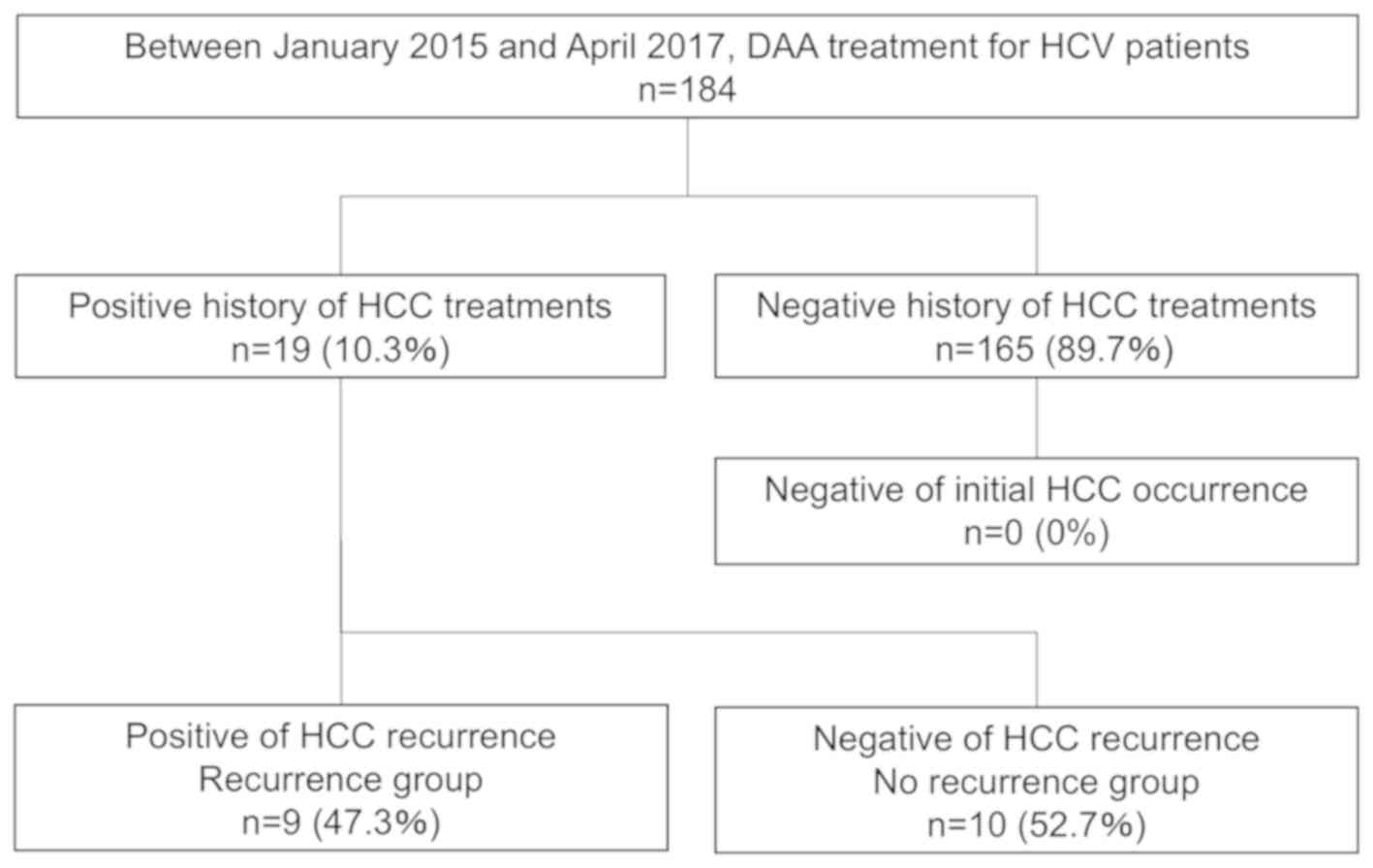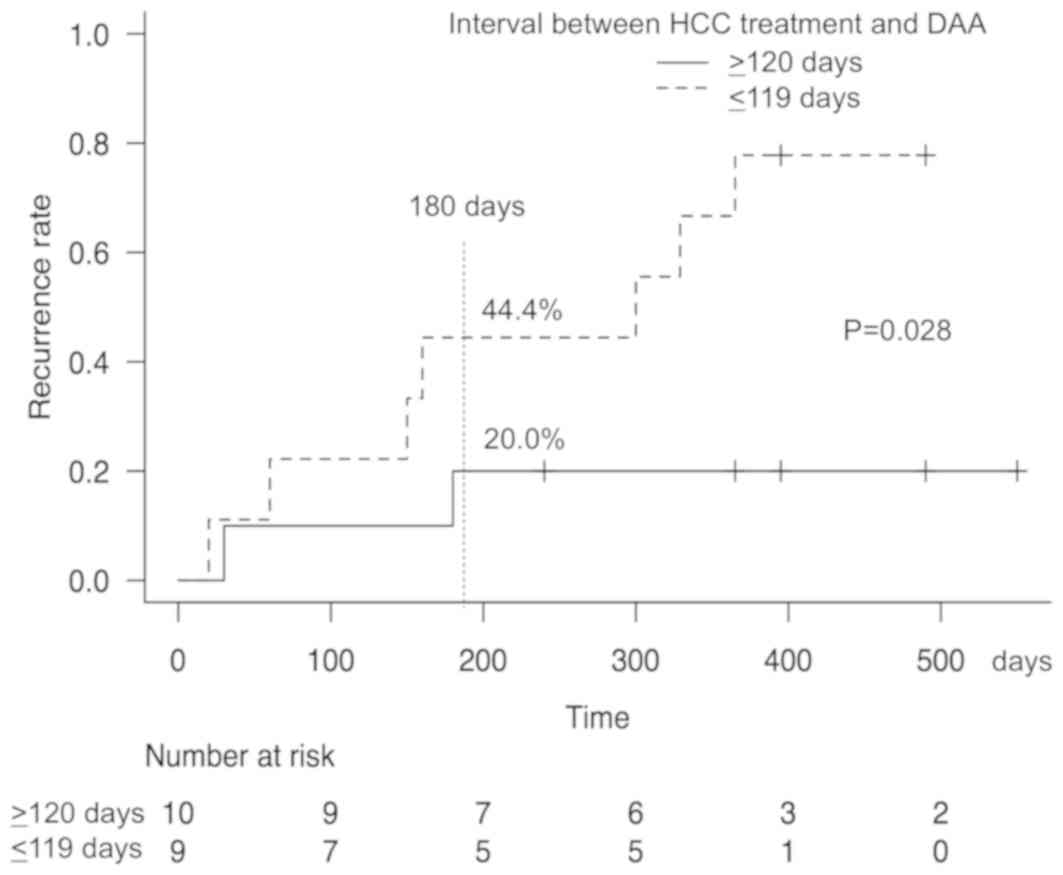|
1
|
Asselah T and Marcellin P: New
direct-acting antivirals' combination for the treatment of chronic
hepatitis C. Liver Int. 31 (Suppl 1):S68–S77. 2011. View Article : Google Scholar
|
|
2
|
Degos F, Christidis C, Ganne-Carrie N,
Farmachidi JP, Degott C, Guettier C, Trinchet JC, Beaugrand M and
Chevret S: Hepatitis C virus related cirrhosis: Time to occurrence
of hepatocellular carcinoma and death. Gut. 47:131–136. 2000.
View Article : Google Scholar : PubMed/NCBI
|
|
3
|
Imai Y, Kawata S, Tamura S, Yabuuchi I,
Noda S, Inada M, Maeda Y, Shirai Y, Fukuzaki T, Kaji I, et al:
Relation of interferon therapy and hepatocellular carcinoma in
patients with chronic hepatitis C. Osaka hepatocellular carcinoma
prevention study group. Ann Intern Med. 129:94–99. 1998. View Article : Google Scholar : PubMed/NCBI
|
|
4
|
Mazzella G, Accogli E, Sottili S, Festi D,
Orsini M, Salzetta A, Novelli V, Cipolla A, Fabbri C, Pezzoli A and
Roda E: Alpha interferon treatment may prevent hepatocellular
carcinoma in HCV-related liver cirrhosis. J Hepatol. 24:141–147.
1996. View Article : Google Scholar : PubMed/NCBI
|
|
5
|
Hiramatsu N, Oze T and Takehara T:
Suppression of hepatocellular carcinoma development in hepatitis C
patients given interferon-based antiviral therapy. Hepatol Res.
45:152–161. 2015. View Article : Google Scholar : PubMed/NCBI
|
|
6
|
Cammà C, Giunta M, Andreone P and Craxì A:
Interferon and prevention of hepatocellular carcinoma in viral
cirrhosis: An evidence-based approach. J Hepatol. 34:593–602. 2001.
View Article : Google Scholar : PubMed/NCBI
|
|
7
|
Ikeda K, Arase Y, Saitoh S, Kobayashi M,
Suzuki Y, Suzuki F, Tsubota A, Chayama K, Murashima N and Kumada H:
Interferon beta prevents recurrence of hepatocellular carcinoma
after complete resection or ablation of the primary tumor-A
prospective randomized study of hepatitis C virus-related liver
cancer. Hepatology. 32:228–232. 2000. View Article : Google Scholar : PubMed/NCBI
|
|
8
|
Kubo S, Nishiguchi S, Hirohashi K, Tanaka
H, Shuto T, Yamazaki O, Shiomi S, Tamori A, Oka H, Igawa S, et al:
Effects of long-term postoperative interferon-alpha therapy on
intrahepatic recurrence after resection of hepatitis C
virus-related hepatocellular carcinoma. A randomized, controlled
trial. Ann Intern Med. 134:963–967. 2001. View Article : Google Scholar : PubMed/NCBI
|
|
9
|
Mazzaferro V, Romito R, Schiavo M, Mariani
L, Camerini T, Bhoori S, Capussotti L, Calise F, Pellicci R, Belli
G, et al: Prevention of hepatocellular carcinoma recurrence with
alpha-interferon after liver resection in HCV cirrhosis.
Hepatology. 44:1543–1554. 2006. View Article : Google Scholar : PubMed/NCBI
|
|
10
|
Morgan TR, Ghany MG, Kim HY, Snow KK,
Shiffman ML, De Santo JL, Lee WM, Di Bisceglie AM, Bonkovsky HL,
Dienstag JL, et al: Outcome of sustained virological responders
with histologically advanced chronic hepatitis C. Hepatology.
52:833–844. 2010. View Article : Google Scholar : PubMed/NCBI
|
|
11
|
Backus LI, Boothroyd DB, Phillips BR,
Belperio P, Halloran J and Mole LA: A sustained virologic response
reduces risk of all-cause mortality in patients with hepatitis C.
Clin Gastroenterol Hepatol. 9:509–516.e1. 2011. View Article : Google Scholar : PubMed/NCBI
|
|
12
|
Lok AS, Seeff LB, Morgan TR, di Bisceglie
AM, Sterling RK, Curto TM, Everson GT, Lindsay KL, Lee WM,
Bonkovsky HL, et al: Incidence of hepatocellular carcinoma and
associated risk factors in hepatitis C-related advanced liver
disease. Gastroenterology. 136:138–148. 2009. View Article : Google Scholar : PubMed/NCBI
|
|
13
|
Kumada H, Suzuki Y, Ikeda K, Toyota J,
Karino Y, Chayama K, Kawakami Y, Ido A, Yamamoto K, Takaguchi K, et
al: Daclatasvir plus asunaprevir for chronic HCV genotype 1b
infection. Hepatology. 59:2083–2091. 2014. View Article : Google Scholar : PubMed/NCBI
|
|
14
|
Omata M, Nishiguchi S, Ueno Y, Mochizuki
H, Izumi N, Ikeda F, Toyoda H, Yokosuka O, Nirei K, Genda T, et al:
Sofosbuvir plus ribavirin in Japanese patients with chronic
genotype 2 HCV infection: An open-label, phase 3 trial. J Viral
Hepat. 21:762–768. 2014. View Article : Google Scholar : PubMed/NCBI
|
|
15
|
Mizokami M, Yokosuka O, Takehara T,
Sakamoto N, Korenaga M, Mochizuki H, Nakane K, Enomoto H, Ikeda F,
Yanase M, et al: Ledipasvir and sofosbuvir fixed-dose combination
with and without ribavirin for 12 weeks in treatment-naive and
previously treated Japanese patients with genotype 1 hepatitis C:
An open-label, randomised, phase 3 trial. Lancet Infect Dis.
15:645–653. 2015. View Article : Google Scholar : PubMed/NCBI
|
|
16
|
Kumada H, Chayama K, Rodrigues L Jr,
Suzuki F, Ikeda K, Toyoda H, Sato K, Karino Y, Matsuzaki Y, Kioka
K, et al: Randomized phase 3 trial of
ombitasvir/paritaprevir/ritonavir for hepatitis C virus genotype
1b-infected Japanese patients with or without cirrhosis.
Hepatology. 62:1037–1046. 2015. View Article : Google Scholar : PubMed/NCBI
|
|
17
|
Reig M, Mariño Z, Perelló C, Iñarrairaegui
M, Ribeiro A, Lens S, Díaz A, Vilana R, Darnell A, Varela M, et al:
Unexpected high rate of early tumor recurrence in patients with
HCV-related HCC undergoing interferon-free therapy. J Hepatol.
65:719–726. 2016. View Article : Google Scholar : PubMed/NCBI
|
|
18
|
Conti F, Buonfiglioli F, Scuteri A, Crespi
C, Bolondi L, Caraceni P, Foschi FG, Lenzi M, Mazzella G, Verucchi
G, et al: Early occurrence and recurrence of hepatocellular
carcinoma in HCV-related cirrhosis treated with direct-acting
antivirals. J Hepatol. 65:727–733. 2016. View Article : Google Scholar : PubMed/NCBI
|
|
19
|
Calleja JL, Crespo J, Rincón D,
Ruiz-Antorán B, Fernandez I, Perelló C, Gea F, Lens S,
García-Samaniego J, Sacristán B, et al: Effectiveness, safety and
clinical outcomes of direct-acting antiviral therapy in HCV
genotype 1 infection: Results from a Spanish real-world cohort. J
Hepatol. 66:1138–1148. 2017. View Article : Google Scholar : PubMed/NCBI
|
|
20
|
ANRS collaborative study group on
hepatocellular carcinoma (ANRS CO22 HEPATHER, CO12 CirVir and CO23
CUPILT cohorts). Electronic address: stanislas.pol@aphp.fr: Lack of
evidence of an effect of direct-acting antivirals on the recurrence
of hepatocellular carcinoma: Data from three ANRS cohorts, . J
Hepatol. 65:734–740. 2016.PubMed/NCBI
|
|
21
|
Prenner SB, VanWagner LB, Flamm SL, Salem
R, Lewandowski RJ and Kulik L: Hepatocellular carcinoma decreases
the chance of successful hepatitis C virus therapy with
direct-acting antivirals. J Hepatol. 66:1173–1181. 2017. View Article : Google Scholar : PubMed/NCBI
|
|
22
|
Manthravadi S, Paleti S and Pandya P:
Impact of sustained viral response postcurative therapy of
hepatitis C-related hepatocellular carcinoma: A systematic review
and meta-analysis. Int J Cancer. 140:1042–1049. 2017. View Article : Google Scholar : PubMed/NCBI
|
|
23
|
Beste LA, Green PK, Berry K, Kogut MJ,
Allison SK and Ioannou GN: Effectiveness of hepatitis C antiviral
treatment in a USA cohort of veteran patients with hepatocellular
carcinoma. J Hepatol. 67:32–39. 2017. View Article : Google Scholar : PubMed/NCBI
|
|
24
|
Iida H, Kaibori M, Matsui K, Ishizaki M
and Kon M: Assessing the feasibility of clinicopathological
features of hepatic resection for hepatocellular carcinoma in
patients over 80 years of age. Mol Clin Oncol. 6:29–38. 2017.
View Article : Google Scholar : PubMed/NCBI
|
|
25
|
Kobayashi M, Suzuki F, Fujiyama S,
Kawamura Y, Sezaki H, Hosaka T, Akuta N, Suzuki Y, Saitoh S, Arase
Y, et al: Sustained virologic response by direct antiviral agents
reduces the incidence of hepatocellular carcinoma in patients with
HCV infection. J Med Virol. 89:476–483. 2017. View Article : Google Scholar : PubMed/NCBI
|
|
26
|
Alberti A and Piovesan S: Increased
incidence of liver cancer after successful DAA treatment of chronic
hepatitis C: Fact or fiction? Liver Int. 37:802–808. 2017.
View Article : Google Scholar : PubMed/NCBI
|
|
27
|
Nagaoki Y, Imamura M, Aikata H, Daijo K,
Teraoka Y, Honda F, Nakamura Y, Hatooka M, Morio R, Morio K, et al:
The risks of hepatocellular carcinoma development after HCV
eradication are similar between patients treated with
peg-interferon plus ribavirin and direct-acting antiviral therapy.
PLoS One. 12:e01827102017. View Article : Google Scholar : PubMed/NCBI
|
|
28
|
Nault JC and Colombo M: Hepatocellular
carcinoma and direct acting antiviral treatments: Controversy after
the revolution. J Hepatol. 65:663–665. 2016. View Article : Google Scholar : PubMed/NCBI
|
|
29
|
Villani R, Facciorusso A, Bellanti F,
Tamborra R, Piscazzi A, Landriscina M, Vendemiale G and Serviddio
G: DAAs rapidly reduce inflammation but increase serum VEGF level:
A rationale for tumor risk during Anti-HCV treatment. PLoS One.
11:e01679342016. View Article : Google Scholar : PubMed/NCBI
|
|
30
|
Tsai PC, Huang CF and Yu ML: Unexpected
early tumor recurrence in patients with hepatitis C virus-related
hepatocellular carcinoma undergoing interferon-free therapy: Issue
of the interval between HCC treatment and antiviral therapy. J
Hepatol. 66:4642017. View Article : Google Scholar : PubMed/NCBI
|
|
31
|
Chan K, Lai MN, Groessl EJ, Hanchate AD,
Wong JB, Clark JA, Asch SM, Gifford AL and Ho SB: Cost
effectiveness of direct-acting antiviral therapy for
treatment-naive patients with chronic HCV genotype 1 infection in
the veterans health administration. Clin Gastroenterol Hepatol.
11:1503–1510. 2013. View Article : Google Scholar : PubMed/NCBI
|
|
32
|
Cortesi PA, Mantovani LG, Ciaccio A, Rota
M, Mazzarelli C, Cesana G, Strazzabosco M and Belli LS:
Cost-effectiveness of new direct-acting antivirals to prevent
post-liver transplant recurrent hepatitis. Am J Transplant.
15:1817–1826. 2015. View Article : Google Scholar : PubMed/NCBI
|
|
33
|
Li DK, Ren Y, Fierer DS, Rutledge S,
Shaikh OS, Lo Re V III, Simon T, Abou-Samra AB, Chung RT and Butt
AA: The short-term incidence of hepatocellular carcinoma is not
increased after hepatitis C treatment with direct-acting
antivirals: An ERCHIVES study. Hepatology. 67:2244–2253. 2018.
View Article : Google Scholar : PubMed/NCBI
|
|
34
|
Guarino M, Viganò L, Ponziani FR, Giannini
EG, Lai Q and Morisco F; Special Interest Group on Hepatocellular
carcinoma and new anti-HCV therapies' of the Italian Association
for the Study of the Liver, : Recurrence of hepatocellular
carcinoma after direct acting antiviral treatment for hepatitis C
virus infection: Literature review and risk analysis. Dig Liver
Dis. 50:1105–1114. 2018. View Article : Google Scholar : PubMed/NCBI
|
|
35
|
Singh S, Nautiyal A and Loke YK: Oral
direct-Acting antivirals and the incidence or recurrence of
hepatocellular carcinoma: A systematic review and meta-analysis.
Frontline Gastroenterol. 9:262–270. 2018. View Article : Google Scholar : PubMed/NCBI
|
|
36
|
Tampaki M, Savvanis S and Koskinas J:
Impact of direct-acting antiviral agents on the development of
hepatocellular carcinoma: Evidence and pathophysiological issues.
Ann Gastroenterol. 31:670–679. 2018.PubMed/NCBI
|
|
37
|
Saraiya N, Yopp AC, Rich NE, Odewole M,
Parikh ND and Singal AG: Systematic review with meta-analysis:
Recurrence of hepatocellular carcinoma following direct-acting
antiviral therapy. Aliment Pharmacol Ther. 48:127–137. 2018.
View Article : Google Scholar : PubMed/NCBI
|
















